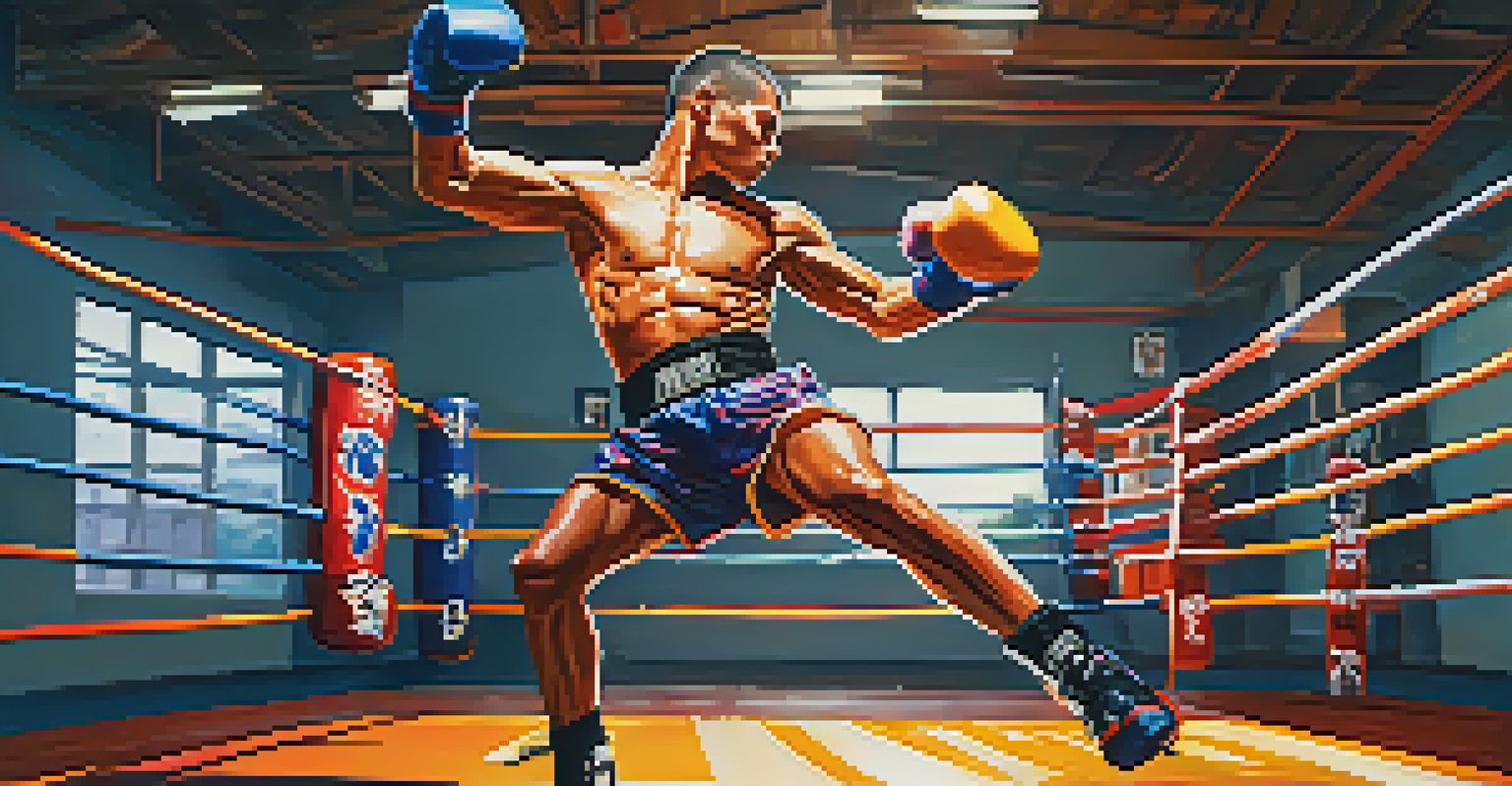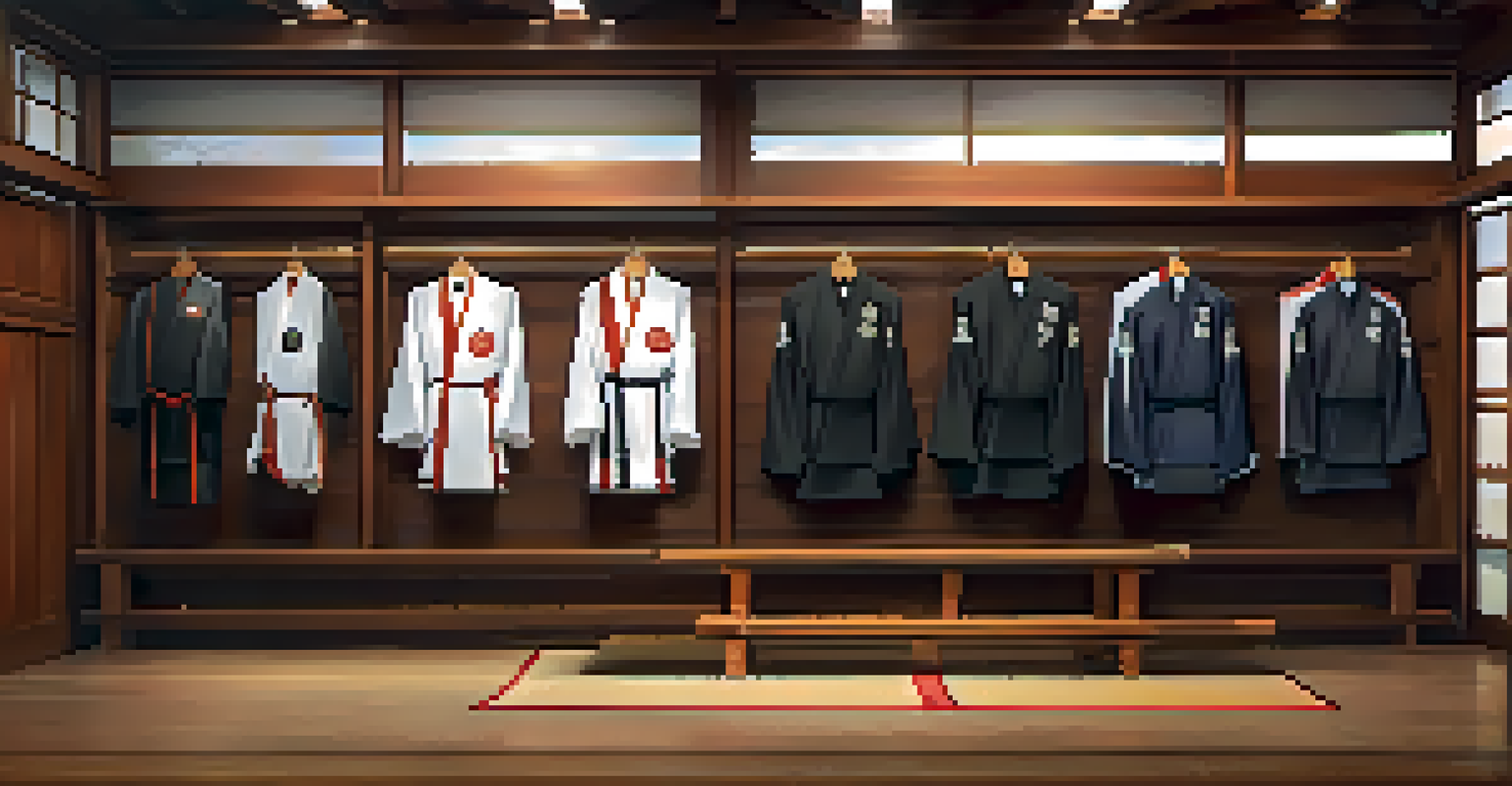The Evolution of Martial Arts and Its Cultural Roots

Understanding Martial Arts: A Brief Overview
Martial arts encompass a wide range of combat practices and traditions, each with its own philosophies and techniques. From the disciplined movements of Tai Chi to the dynamic strikes of Muay Thai, these arts are not just about physical prowess; they often embody cultural values and historical narratives. By understanding martial arts, we can appreciate the intricate connection between physical training and cultural heritage.
Martial arts are not about the martial arts themselves; they are about the person you become through the training.
These practices have evolved over centuries, influenced by societal changes, wars, and the mingling of cultures. For instance, karate originated in Okinawa, Japan, but was significantly shaped by Chinese martial arts. This blend of influences highlights how martial arts serve as a reflection of the societies from which they emerge.
Moreover, martial arts are often more than mere fighting techniques; they can be a way of life for practitioners. They instill discipline, respect, and a sense of community, allowing individuals to connect with their cultural roots while pursuing personal growth.
The Historical Roots of Martial Arts
The origins of martial arts can be traced back thousands of years, with evidence found in ancient texts and artifacts. From the battlefield techniques of ancient warriors to the ceremonial practices of early civilizations, martial arts have always served practical and spiritual purposes. For example, the ancient Greeks practiced Pankration, a combination of boxing and wrestling, which was part of the Olympic Games.

As civilizations advanced, martial arts began to take on more structured forms. In China, the development of kung fu intertwined with philosophy, particularly Taoism and Buddhism, emphasizing balance and harmony. This historical context not only shaped techniques but also infused martial arts with deeper meaning, making them integral to cultural identity.
Martial Arts Reflect Cultural Values
Martial arts embody the cultural values and historical narratives of their origins, illustrating a deep connection between physical practices and societal beliefs.
In many cultures, martial arts were also used for self-defense and military training, adapting to the needs of the time. The samurai of Japan practiced various forms of combat, which not only prepared them for battle but also cultivated a code of honor, known as Bushido, that influenced Japanese culture profoundly.
Cultural Significance of Martial Arts
Martial arts often reflect the cultural values and social norms of their places of origin. For instance, Brazilian Jiu-Jitsu emphasizes leverage and technique over brute strength, mirroring the Brazilian spirit of ingenuity and adaptability. This cultural lens provides insight into why specific techniques and philosophies resonate with practitioners.
The ultimate aim of martial arts is not having to use them.
Additionally, martial arts can serve as a means of cultural preservation. Many traditional practices have been passed down through generations, preserving not just fighting techniques but also stories, rituals, and values. This makes martial arts a living history, a way for communities to maintain their heritage.
Furthermore, the global popularity of martial arts has fostered cross-cultural exchanges, allowing diverse communities to learn from one another. Events like mixed martial arts (MMA) competitions showcase a variety of styles, creating a melting pot of techniques that enrich the martial arts landscape.
Martial Arts as a Tool for Personal Development
Beyond physical skills, martial arts are often a journey of personal growth. Many practitioners find that training cultivates qualities such as discipline, focus, and resilience. These attributes can translate into everyday life, helping individuals navigate challenges with a stronger mindset.
For many, the dojo or training hall becomes a second home, fostering a sense of belonging and community. This environment encourages mutual respect and support, reinforcing the idea that martial arts are about more than just competition—they’re about personal connections and shared journeys.
Personal Growth Through Training
Training in martial arts fosters qualities such as discipline, focus, and resilience, which can significantly enhance personal development and mental well-being.
Moreover, martial arts often emphasize the importance of mental well-being. Practices such as meditation, found in disciplines like Aikido and Tai Chi, contribute to stress relief and mental clarity, showcasing how martial arts can support holistic health.
The Global Spread of Martial Arts
Martial arts have transcended their geographical origins, spreading across the globe and adapting to different cultures. This globalization has led to the fusion of various styles, creating new disciplines like Capoeira, which blends dance, music, and martial arts from Brazil. This cross-pollination enriches the martial arts community, making it more diverse and inclusive.
Additionally, the rise of social media and online platforms has facilitated the sharing of techniques and philosophies worldwide. Practitioners can now connect and learn from masters across continents, breaking down barriers that once limited access to knowledge. This accessibility has democratized martial arts, allowing everyone to explore its benefits.
However, this global spread also raises questions about cultural appropriation and authenticity. As martial arts become popularized, it’s crucial to respect and honor their roots, ensuring that the practices are transmitted with the cultural context intact.
Modern Trends in Martial Arts Training
In recent years, martial arts training has evolved to include modern techniques and technologies. Fitness-focused programs, such as kickboxing and mixed martial arts, attract diverse audiences, blending traditional practices with contemporary fitness trends. This fusion makes martial arts more accessible and appealing to those seeking a fun and effective way to stay fit.
Moreover, the rise of self-defense classes has highlighted the practical applications of martial arts in everyday life. Many individuals are turning to martial arts not just for fitness but also for empowerment and safety, learning how to protect themselves in various situations. These classes often emphasize situational awareness and conflict resolution, broadening the scope of what martial arts can offer.
Globalization and Cultural Exchange
The global spread of martial arts has led to a fusion of styles and techniques, creating a more diverse community while raising questions about cultural integrity.
Lastly, the integration of mental health awareness into martial arts training is gaining traction. Many schools now incorporate mindfulness and well-being practices, recognizing the profound impact that mental clarity can have on physical performance. This holistic approach reflects a growing understanding of the interconnectedness of mind and body.
The Future of Martial Arts: Keeping Tradition Alive
As martial arts continue to evolve, there’s an ongoing conversation about preserving traditional practices while embracing modern influences. Many practitioners advocate for maintaining the core philosophies and techniques that define each martial art, ensuring that future generations can appreciate their cultural significance. This balance between tradition and innovation is a key challenge for martial arts schools today.
Moreover, as martial arts gain more recognition in sports and entertainment, there’s a unique opportunity to highlight their cultural roots. Movies, documentaries, and competitions can serve as platforms to educate audiences about the rich histories behind these practices, fostering greater respect and appreciation.

Ultimately, the future of martial arts rests in the hands of its practitioners, who must navigate the delicate dance of honoring tradition while adapting to contemporary needs. By doing so, they can ensure that martial arts remain a vibrant and meaningful practice for future generations.